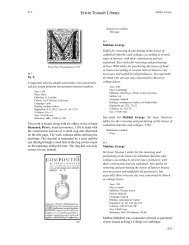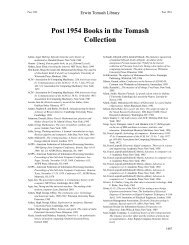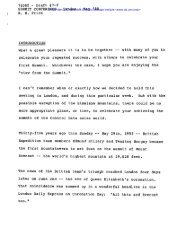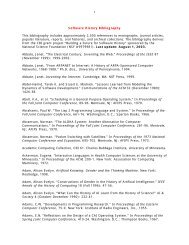B chapter.indd - Charles Babbage Institute - University of Minnesota
B chapter.indd - Charles Babbage Institute - University of Minnesota
B chapter.indd - Charles Babbage Institute - University of Minnesota
You also want an ePaper? Increase the reach of your titles
YUMPU automatically turns print PDFs into web optimized ePapers that Google loves.
130<br />
Publisher: Longmans, Green and Co.<br />
Edition: 1st<br />
Language: English<br />
Binding: original cloth boards<br />
Pagination: pp. viii, 303, [1]<br />
Collation: A 4 B–U 8<br />
Size: 213x136 mm<br />
The design and operations <strong>of</strong> the Jacquard loom and its<br />
variants are described herein, as well as the manner in<br />
which they are set up to produce weavings <strong>of</strong> various<br />
kinds.<br />
Joseph Marie Jacquard (1752–1834) was a mechanic in<br />
Lyons who had invented a machine for weaving fishing<br />
nets. He appears to have begun experiments on improving<br />
ordinary weaving looms about 1790—a model <strong>of</strong> a<br />
machine <strong>of</strong> this date is in the Conservatoire des Arts et<br />
Métier in Paris, but it is not a Jacquard loom as we know<br />
it today. About 1804, he was brought to Paris to repair<br />
Vaucanson’s loom (an earlier punched tape version <strong>of</strong><br />
the automatic loom), and it seems that his attention was<br />
drawn to the potential <strong>of</strong> this technology at that time.<br />
Jacquard’s birth name was Joseph Marie <strong>Charles</strong>—the<br />
extended family had nicknames for each branch, and he<br />
adopted the nickname Jacquard as his formal surname.<br />
Illustrations available:<br />
Title page<br />
B 134<br />
Belli, Silvio Vicentin (–1575)<br />
Libro del misurar con la vista …. Nel quale<br />
s’insegna, senza trauagliar con numeri, a misurar<br />
facilissimamente le distantie, l’altezze, e le pr<strong>of</strong>ondità<br />
con il quadrato geometrico, e con altri stromenti, de’<br />
Erwin Tomash Library<br />
Belli, Silvio Vicentin Belli, Silvio Vicentin<br />
B 133<br />
quali in ogni luogo quasi in un subito si puo prouedere.<br />
Si mostra ancora una bellissima uia di ritrouare<br />
la pr<strong>of</strong>ondità di qual si uoglia mare; & un modo<br />
industrioso di misurar il circuito di tutta la terra.<br />
Year: 1565<br />
Place: Venice<br />
Publisher: Giordano Ziletti<br />
Edition: 1st<br />
Language: Italian<br />
Figures: 54 woodcut diagrams in text<br />
Binding: 18th-century Italian paper boards<br />
Pagination: pp. [8], 108<br />
Collation: * 4 A–N 4 O 2<br />
Size: 194x140 mm<br />
Reference: Rcdi BMI Vol. I, p. 107; Kie SI, p. 116<br />
B 134<br />
Belli taught mathematics in Vicenza and was a founding<br />
member <strong>of</strong> the Accademia Olimpica in 1555. He later<br />
became an architect, practicing in Ferrara, Modena,<br />
Rome and Venice.<br />
His work on surveying was very popular and had at least<br />
six editions in the sixteenth century. It was later combined<br />
with another <strong>of</strong> Belli’s works (Della Proportione, 1573)<br />
and published as Quattro libri giometici in 1595.<br />
In this book Belli deals mainly with simple survey<br />
problems for which rough estimates <strong>of</strong> distances and<br />
heights suffice and describes the use <strong>of</strong> a geometrical<br />
square with a sighting vane. He gives many examples<br />
<strong>of</strong> estimating the solution to a problem by creating<br />
scale drawings on drumheads (essentially using them<br />
as a plane table), improvising survey instruments from<br />
a pair <strong>of</strong> sticks and even estimating distances using the







